Abstract
Heme oxygenase (decyclizing) [heme,hydrogen-donor:oxygen oxidoreductase (α-methene-oxidizing, hydroxylating), EC 1.14.99.3] is greatly induced in the kidney by the administration of nickel or tin. Manganese, when administered simultaneously with nickel or tin in an equimolar amount, substantially inhibited the induction of heme oxygenase. The extent of inhibition was 80% and 98%, respectively. In rats pretreated up to 8 hr with manganese, the level of induction of heme oxygenase by nickel or tin was markedly reduced in a time-dependent fashion. Manganese treatment after the inducing metal was relatively ineffective in preventing the induction of heme oxygenase. Manganese in vitro did not inhibit heme oxygenase in the microsomes isolated from either control or tin-induced rats and in vivo did not increase the rate of catabolism of the induced enzyme. Magnesium was unable to block nickel or tin induction of heme oxygenase. Zinc in equimolar amounts could also substantially reduce the extent of induction of renal heme oxygenase when administered simultaneously with nickel or tin. In addition, simultaneous zinc administration blocked to a considerable extent the induction of hepatic heme oxygenase by nickel, cobalt, or cadmium. These findings indicate the existence of metal—metal interactions that can greatly influence the regulatory mechanism for the induced synthesis of heme oxygenase, the rate-limiting enzyme in heme degradation.
Keywords: heme oxidation, metal—metal interaction
Full text
PDF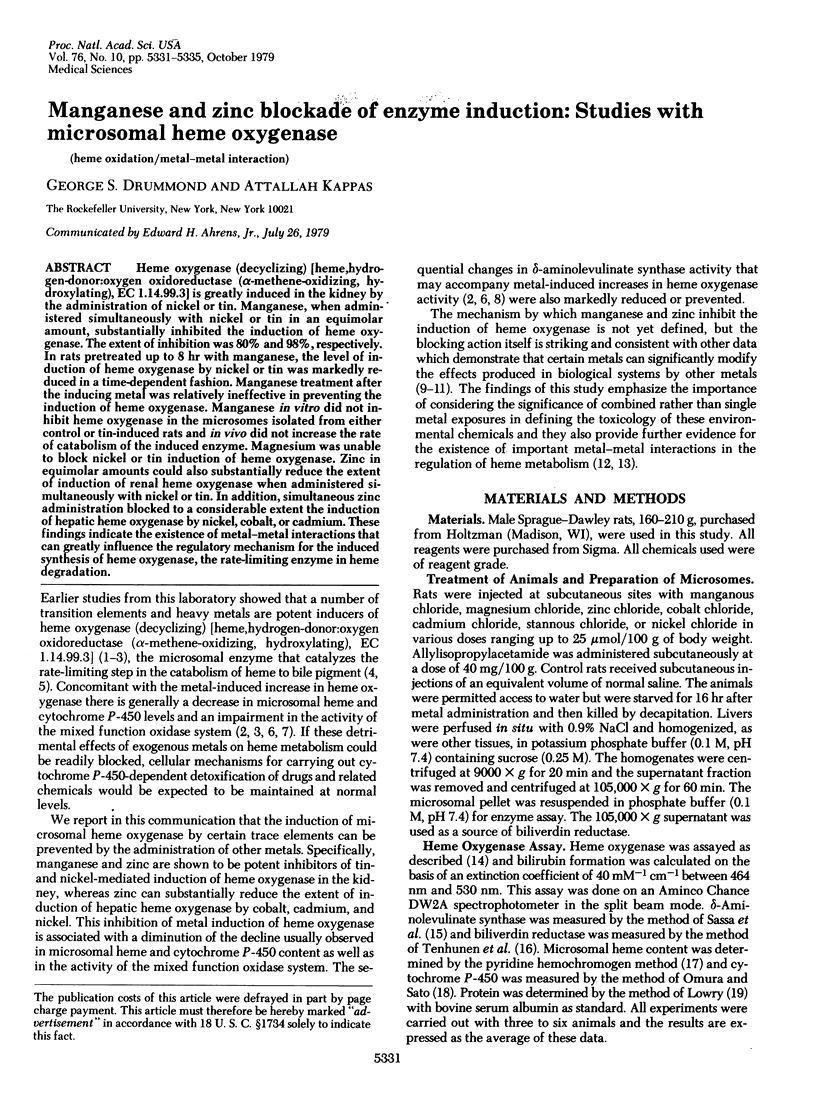
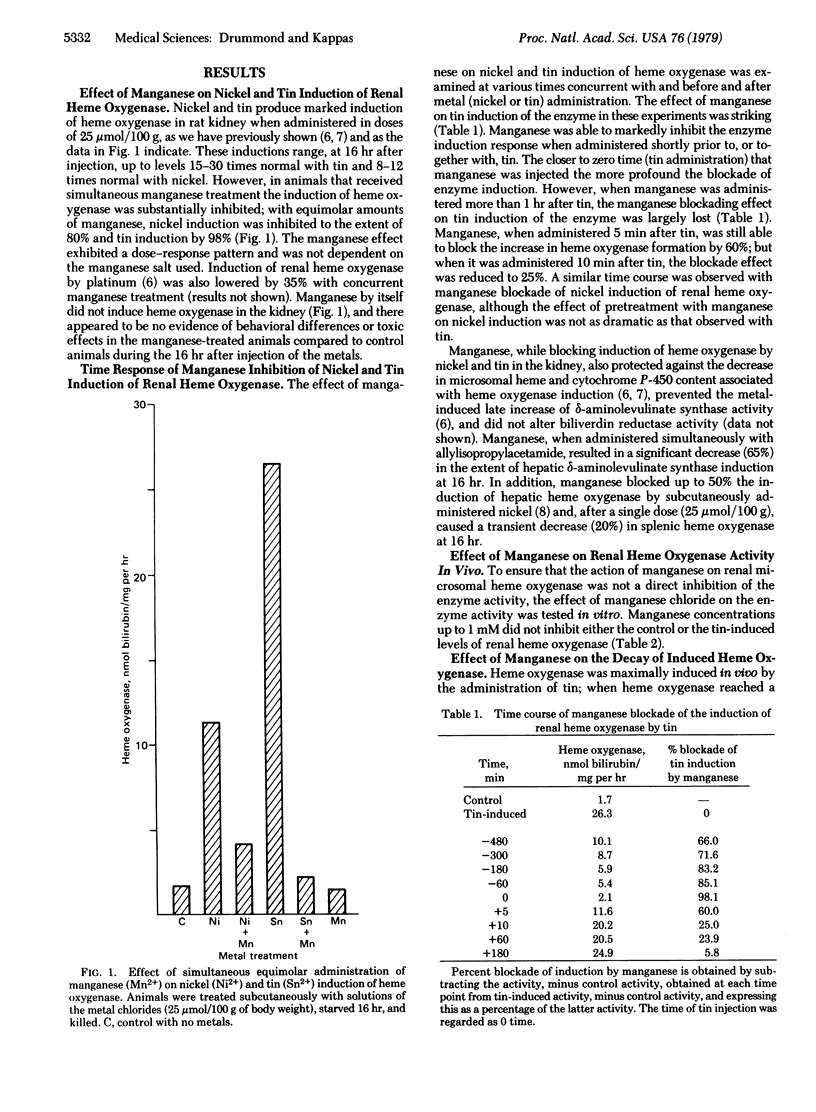
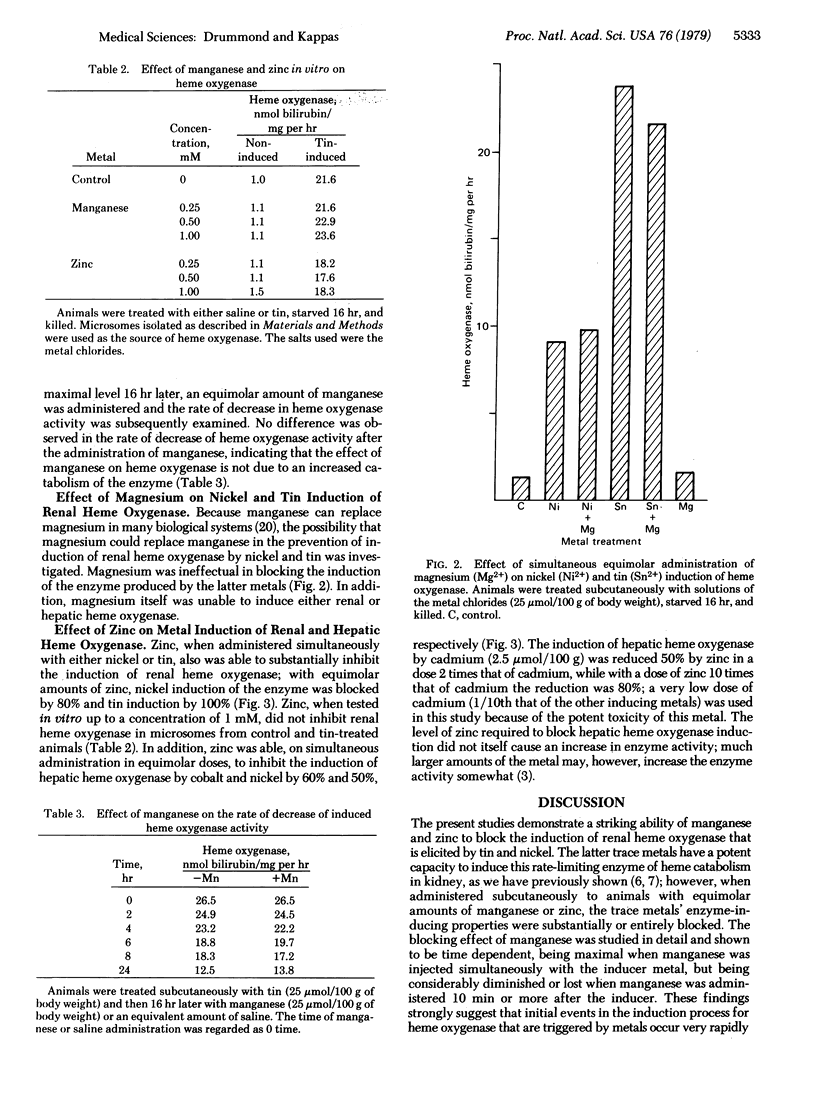
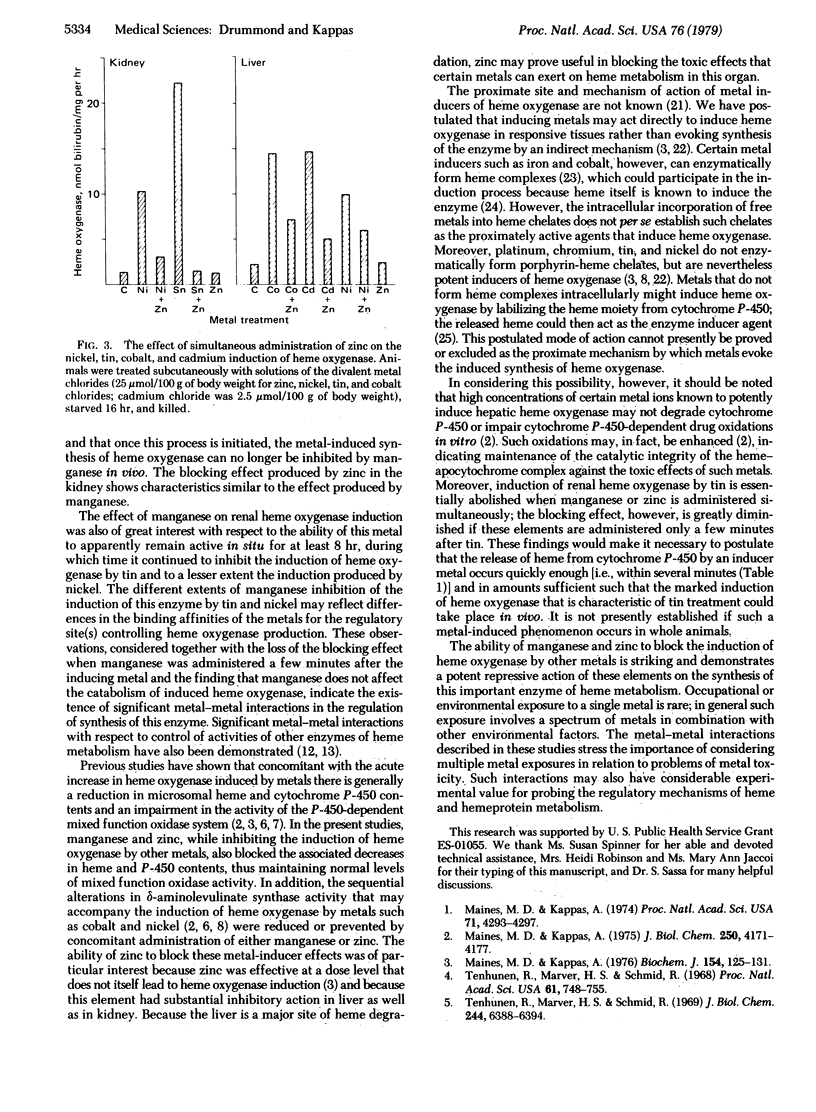
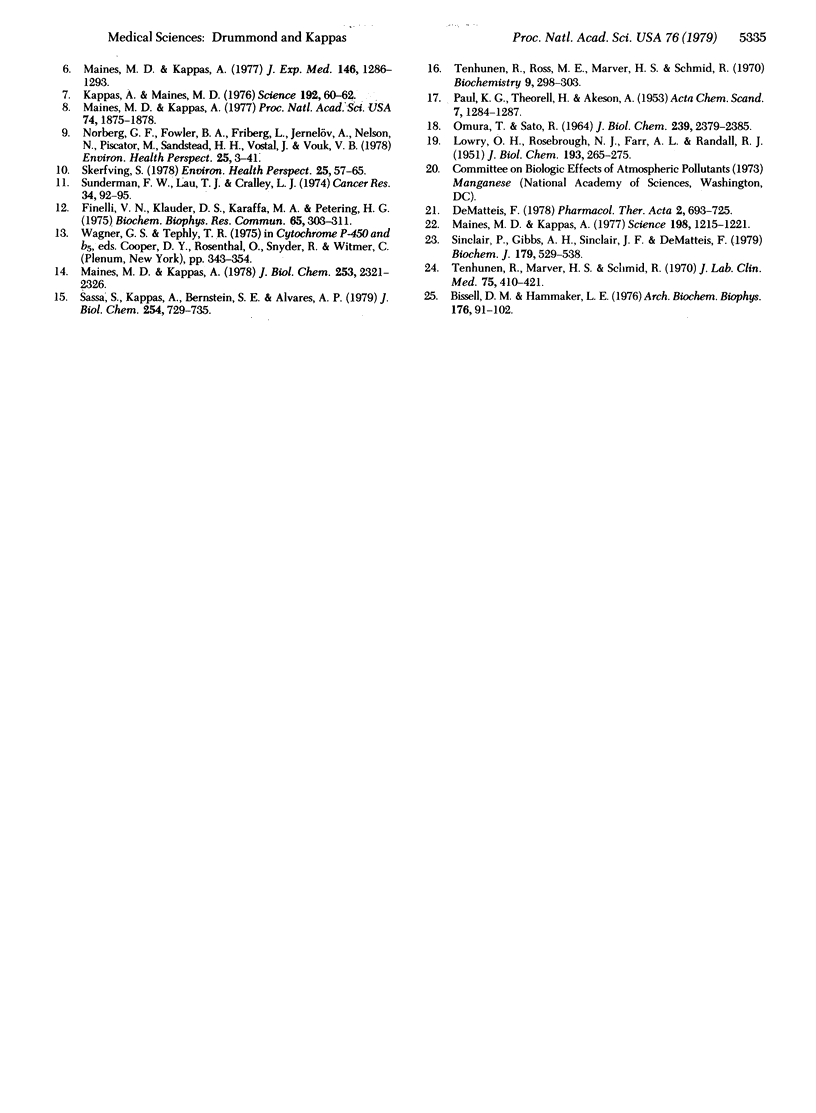
Selected References
These references are in PubMed. This may not be the complete list of references from this article.
- Bissell D. M., Hammaker L. E. Cytochrome P-450 heme and the regulation of hepatic heme oxygenase activity. Arch Biochem Biophys. 1976 Sep;176(1):91–102. doi: 10.1016/0003-9861(76)90144-2. [DOI] [PubMed] [Google Scholar]
- Finelli V. N., Klauder D. S., Karaffa M. A., Petering H. G. Interaction of zinc and lead on delta-aminolevulinate dehydratase. Biochem Biophys Res Commun. 1975 Jul 8;65(1):303–312. doi: 10.1016/s0006-291x(75)80093-3. [DOI] [PubMed] [Google Scholar]
- Kappas A., Maines M. D. Tin: a potent inducer of heme oxygenase in kidney. Science. 1976 Apr 2;192(4234):60–62. doi: 10.1126/science.1257757. [DOI] [PubMed] [Google Scholar]
- LOWRY O. H., ROSEBROUGH N. J., FARR A. L., RANDALL R. J. Protein measurement with the Folin phenol reagent. J Biol Chem. 1951 Nov;193(1):265–275. [PubMed] [Google Scholar]
- Maines M. D., Kappas A. Cobalt induction of hepatic heme oxygenase; with evidence that cytochrome P-450 is not essential for this enzyme activity. Proc Natl Acad Sci U S A. 1974 Nov;71(11):4293–4297. doi: 10.1073/pnas.71.11.4293. [DOI] [PMC free article] [PubMed] [Google Scholar]
- Maines M. D., Kappas A. Cobalt stimulation of heme degradation in the liver. Dissociation of microsomal oxidation of heme from cytochrome P-450. J Biol Chem. 1975 Jun 10;250(11):4171–4177. [PubMed] [Google Scholar]
- Maines M. D., Kappas A. Enzymes of heme metabolism in the kidney: regulation by trace metals which do not form heme complexes. J Exp Med. 1977 Nov 1;146(5):1286–1293. doi: 10.1084/jem.146.5.1286. [DOI] [PMC free article] [PubMed] [Google Scholar]
- Maines M. D., Kappas A. Metals as regulators of heme metabolism. Science. 1977 Dec 23;198(4323):1215–1221. doi: 10.1126/science.337492. [DOI] [PubMed] [Google Scholar]
- Maines M. D., Kappas A. Prematurely evoked synthesis and induction of delta-aminolevulinate synthetase in neonatal liver. Evidence for metal ion repression of enzyme formation. J Biol Chem. 1978 Apr 10;253(7):2321–2326. [PubMed] [Google Scholar]
- Maines M. D., Kappas A. Regulation of heme pathway enzymes and cellular glutathione content by metals that do not chelate with tetrapyrroles: blockade of metal effects by thiols. Proc Natl Acad Sci U S A. 1977 May;74(5):1875–1878. doi: 10.1073/pnas.74.5.1875. [DOI] [PMC free article] [PubMed] [Google Scholar]
- Maines M. D., Kappas A. Studies on the mechanism of induction of haem oxygenase by cobalt and other metal ions. Biochem J. 1976 Jan 15;154(1):125–131. doi: 10.1042/bj1540125. [DOI] [PMC free article] [PubMed] [Google Scholar]
- OMURA T., SATO R. THE CARBON MONOXIDE-BINDING PIGMENT OF LIVER MICROSOMES. II. SOLUBILIZATION, PURIFICATION, AND PROPERTIES. J Biol Chem. 1964 Jul;239:2379–2385. [PubMed] [Google Scholar]
- Sassa S., Kappas A., Bernstein S. E., Alvares A. P. Heme biosynthesis and drug metabolism in mice with hereditary hemolytic anemia. Heme oxygenase induction as an adaptive response for maintaining cytochrome P-450 in chronic hemolysis. J Biol Chem. 1979 Feb 10;254(3):729–735. [PubMed] [Google Scholar]
- Sinclair P., Gibbs A. H., Sinclair J. F., de Matteis F. Formation of cobalt protoporphyrin in the liver of rats. A mechanism for the inhibition of liver haem biosynthesis by inorganic cobalt. Biochem J. 1979 Mar 15;178(3):529–538. doi: 10.1042/bj1780529. [DOI] [PMC free article] [PubMed] [Google Scholar]
- Skerfving S. Interaction between selenium and methylmercury. Environ Health Perspect. 1978 Aug;25:57–65. doi: 10.1289/ehp.782557. [DOI] [PMC free article] [PubMed] [Google Scholar]
- Sunderman F. W., Jr, Lau T. J., Cralley L. J. Inhibitory effect of manganese upon muscle tumorigenesis by nickel subsulfide. Cancer Res. 1974 Jan;34(1):92–95. [PubMed] [Google Scholar]
- Tenhunen R., Marver H. S., Schmid R. Microsomal heme oxygenase. Characterization of the enzyme. J Biol Chem. 1969 Dec 10;244(23):6388–6394. [PubMed] [Google Scholar]
- Tenhunen R., Marver H. S., Schmid R. The enzymatic catabolism of hemoglobin: stimulation of microsomal heme oxygenase by hemin. J Lab Clin Med. 1970 Mar;75(3):410–421. [PubMed] [Google Scholar]
- Tenhunen R., Marver H. S., Schmid R. The enzymatic conversion of heme to bilirubin by microsomal heme oxygenase. Proc Natl Acad Sci U S A. 1968 Oct;61(2):748–755. doi: 10.1073/pnas.61.2.748. [DOI] [PMC free article] [PubMed] [Google Scholar]
- Tenhunen R., Ross M. E., Marver H. S., Schmid R. Reduced nicotinamide-adenine dinucleotide phosphate dependent biliverdin reductase: partial purification and characterization. Biochemistry. 1970 Jan 20;9(2):298–303. doi: 10.1021/bi00804a016. [DOI] [PubMed] [Google Scholar]


